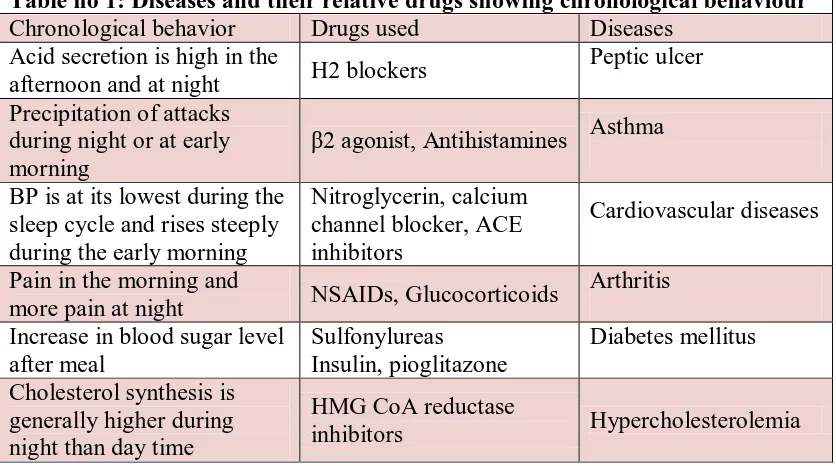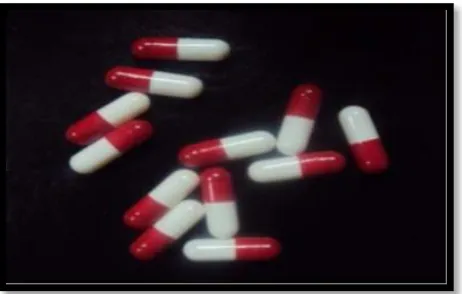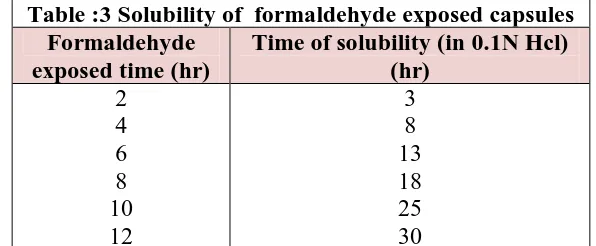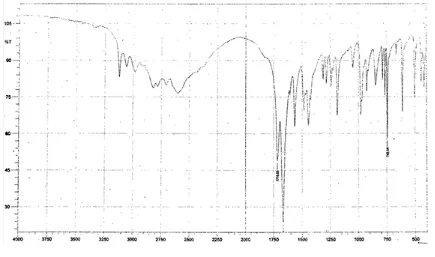www.wjpr.net Vol 3, Issue 9, 2014. 742
FORMULATION AND EVALUATION OF COLON TARGETTED
PULSE IN CAP SYSTEMS OF THEOPHYLLINE FOR NOCTURNAL
ASTHMA
Pasam jyothirmayi*1 B.sivaranjani2
Vikas college of pharmacy, vissannapeta, Krishna dist.
ABSTRACT
Asthma may be the most common disease with the largest circadian variation. Nocturnal asthma is currently controlled by taking either a long-acting β2 agonists like salmetrol inhalers, or bronchodilator such as sustained release Theophylline. The oral route is considered to be most convenient for the administration of drugs to patients. But it has a serious drawback in conditions where localized delivery of the drug in the colon is required. The objective of the present study was to develop and evaluate an oral pulsatile drug delivery system for asthma by releasing the drug with a distinct predetermined lag time of 5 hrs to prolong the release and for colon targeting of TPH to treat the nocturnal symptoms of asthma. If the formulation is administered in the night at 10.00 pm symptoms that are experienced in early morning hours could be avoided. In the present study, polymers such as hydroxyl propyl methyl cellulose and Xanthan gum selected for colon targeting of TPH. TPH granules were prepared by wet granulation and polymer plugs were prepared by using polymers hydroxyl propyl methyl cellulose and xanthane gum to prolong the release and target to the colon. These granules filled into the formaldehyde treated capsules and plugged with optimized polymer plug to maintain the 5hr lag time. Finally capsules are enteric coated with enteric coating polymers and conducted dissolution studies.
KEYWORDS: Asthma, Pulsatile drug delivery system of theophylline, Chrono-biological
action, Pulse in cap systems, colon targeted drug delivery.
INTRODUCTION
Chronobiology is the scientific study of biologic rhythms and their underlying mechanisms. Application of the principles of chronobiology may help in disease prevention, aid in early
Volume 3, Issue 9, 742-754. Research Article ISSN 2277– 7105
Article Received on 24 August 2014,
Revised on 17 Sept 2014, Accepted on 12 Oct 2014
*Correspondence for
Author
Dr. Pasam Jyothirmayi
Vikas college of pharmacy,
www.wjpr.net Vol 3, Issue 9, 2014. 743 diagnosis and treatment, and reduce overall health care costs. Chronotherapeutics is defined as a treatment system where the in vivo drug availability has been timed in accordance to cyclic rhythms of drug related biological phenomena to create maximum benefit minimizing harm.[1] In chrono-pharmacotherapy (timed drug therapy) drug administration is synchronized with biological rhythms to produce maximal therapeutic effect and minimum harm for the patient. By basing drug delivery on circadian patterns of diseases drug effect can be optimized and side effects can be reduced [2]. If symptoms occur at daytime a conventional dosage form can be administered just prior the symptoms are worsening. If symptoms of a disease became worse during the night or in the early morning the timing of drug administration and nature of the drug delivery system need careful consideration.
[image:2.595.90.508.521.754.2]Though most delivery systems are designed for constant drug release over a prolonged period of time, pulsatile delivery systems are characterized by a programmed drug release, as constant blood levels of a drug may not always be desirable. Pulsatile systems are gaining a lot of interest as they deliver the drug at the right site of action at the right time thus providing spatial and temporal delivery and increasing patient compliance. Pulsatile systems are designed in a manner that the drug is available at the site of action at the right time in the right amount [3-6]. These systems are beneficial for drugs having high first-pass effect; drugs administered for diseases that follow chrono-pharmacological behaviour; drugs having specific absorption site in GIT, targeting to colon; and cases where night time dosing is required.
Table no 1: Diseases and their relative drugs showing chronological behaviour Chronological behavior Drugs used Diseases
Acid secretion is high in the
afternoon and at night H2 blockers
Peptic ulcer
Precipitation of attacks during night or at early morning
β2 agonist, Antihistamines Asthma
BP is at its lowest during the sleep cycle and rises steeply during the early morning
Nitroglycerin, calcium channel blocker, ACE inhibitors
Cardiovascular diseases
Pain in the morning and
more pain at night NSAIDs, Glucocorticoids
Arthritis
Increase in blood sugar level after meal
Sulfonylureas Insulin, pioglitazone
Diabetes mellitus
Cholesterol synthesis is generally higher during night than day time
HMG CoA reductase
www.wjpr.net Vol 3, Issue 9, 2014. 744 For several drugs or therapies, a pulsatile release profile, where the drug is released completely after a defined lag time, is advantageous [7] which develop biological tolerance, for drugs with an extensive first pass metabolism, for drugs targeted to a specific site in the intestinal tract, e.g. to the colon, protecting the drug from degradation and for the adaptation of drug needs to circadian rhythms of body functions or diseases [8-10]. With eroding or dissolving systems, a potential problem is the retardation and therefore there is no immediate drug release after the loss of the barrier function or a premature release, seen in particular with highly water-soluble drugs [11-13].
www.wjpr.net Vol 3, Issue 9, 2014. 745 Fig. 1: Mechanism of drug release from pulsed based chronopharmaceutical drug
delivery.
MATERIALS AND METHODS
Materials: The following chemicals were obtained from commercial suppliers and used as received: Theophylline (Cipla, Bangalore, India), PVP K30 ( Dr Reddy’s Pvt. Ltd., Hyderabad), Crosspovidone XL-10 (International Specialty Inc, Hyderabad), Ethyl cellulose (BurgoymeBurdiges&Co, Mumbai), HPMC 50Cps (NATCO Pharma Pvt. Ltd, Kothur), Xanthane gum (BurgoymeBurdiges&Co, Mumbai) , Hard Gelatin capsule shells (00 size) (NATCO Pharma Pvt. Ltd, Kothur), Cellulose acetate phthalate (Qualigens fine chemicals, Mumbai), Sodium Starch Glycolate, Formaldehyde solution and lactose.
FORMULATION OF PULSINCAP SYSTEMS
Preparation of theophylline granules
[image:4.595.104.495.74.203.2]Theophylline granules were prepared by wet granulation method. The composition of different formulations used in the study is given in Table 2. In all the formulations, lactose, sodium starch glycolate, starch were sieved (<250 mm) separately and mixed with Theophylline (<150 mm) and PVP (<250 mm). The powders were blended and granulated
Table no 2: Composition of TPH granules.
S.no Ingredients Composition(mg)
1. Theophylline 300
2. Lactose 25
3. Starch (5%) Qs
4 PVPK30 (5%) Qs
5 Sodium starch glycolate 25
Table no 3: Composition of polymer plug
S. No Ingredients F-1
(mg) F-2 (mg)
F-3 (mg)
F-4 (mg)
[image:4.595.147.453.481.679.2]www.wjpr.net Vol 3, Issue 9, 2014. 746 with 5% of PVPK30, starch (1:1) was used as granulating agents. The wet mass was passed through a mesh and granules were dried at 50ºc for 2 hr.
Preparation of Formaldehyde-Exposed Hard Gelatin Capsules
Bodies of hard gelatin capsules (0 size) were placed on a wire mesh. Formaldehyde 15% was taken into a dessicator. The wire mesh containing bodies was then exposed to formaldehyde vapors. The reaction was carried out for 12 hr after which the bodies were removed and dried at 50ºc for 12 hr to ensure completion of reaction between gelatin and formaldehyde vapours. The bodies were then dried at room temperature to ensure removal of residual formaldehyde.
Development of Pulsincap Dosage Form
Granules equivalent to the dose of TPH were accurately weighed and filled in to the formaldehyde exposed bodies by hand filling. Capsules containing the granules were then plugged with different combinations of Hydroxyl propyl methyl cellulose, with Xanthane gum (Table 5). Plugs were punched by 8mm punch. It is called as tablet plug. The filled capsules were then completely coated with different enteric coated polymers, separately at different concentrations. Cellulose acetate phthalate of 2.5, 5 and 10% coating solutions were prepared using solvent acetone and mixed with 1% PEG as plasticizer (Table 6). Coating was repeated until an 8-12% increase in weight was obtained. % weight gain of the capsules before and after coating was determined.
Characterization of Modified Pulsincap Systems
Characterisation by Preformulation Study of Pure Drug
[image:5.595.179.410.479.626.2]The IR spectrum & melting range of pure drug was compared with that of reference standard IR spectrum of theophylline given in British pharmacopoeia, thus indicating purity of the drug sample.
www.wjpr.net Vol 3, Issue 9, 2014. 747 Characterization of Granules
The granules prepared in the formulation were subjected for characterization of flow and derived properties.
Bulk Density (DB): It is the ratio of total mass of powder to the bulk volume of powder. It
was measured by pouring the weighed powder into a measuring cylinder and the volume was noted. It is expressed in gm/ml and is given by
Db
Where, M= mass of powder. Vb=bulk volume of the powder.
Tapped Density (Dt): It is the ratio of total mass of powder to the tapped volume of powder.
The tapped volume was measured by tapping the powder to constant volume. It is expressed in gm/ml and is given by.
Dt
Where, M=mass of powder. Vt=tapped volume of the powder.
Carr’s Index (I): It indicates the ease with which a material can be induced to flow. It is
expressed in percentage and is given by
I
Where, Dt = tapped density of the powder.
Db=bulk density of the powder.
Angle of Repose (θ): It is defined as maximum angle possible between the surface of a pile of
powder and the horizontal plane.
θ=tan-1(h/r)
Where, θ= is the angle of repose h = is the height & r= is the radius.
www.wjpr.net Vol 3, Issue 9, 2014. 748 height. The angle of repose was then calculated by measuring the height and radius of the heap of powder formed.
Study of Dimensions of Capsule after Formaldehyde Treatment
Variations in dimensions between treated and untreated capsules were studied. The length and diameter of capsules were measured before and after treatment with formaldehyde.
Chemical Test for Free Formaldehyde
Standard formaldehyde solution used is formaldehyde solution (0.002, w/v) and sample solution is formaldehyde treated bodies (about 25 in number) were cut into small pieces and taken into a beaker containing distilled water. This was stirred for 1 h with a magnetic stirrer, to solubilize the free formaldehyde. The solution was then filtered into a 50ml volumetric flask, washed with distilled water and volume was made up to 50 ml with the washings. In brief, to 1ml of sample solution, 9ml of water was added. One milliliter of resulting solution was taken into a test tube and mixed with 4ml of water and 5ml of acetone reagent. The test tube was warmed in a water bath at 40oC and allowed to stand for 40 min, at the same time standard solution is placed in same manner using 1ml standard formaldehyde solution. The color intensity of sample solution must not be more than standard solution color intensity.
Solubility Study of Formaldehyde Exposed Capsule Body
The Capsule bodies were exposed to 15% formaldehyde solution in varying time intervals. Then exposed capsule bodies were dried in an hot air oven. And the solubility of bodies were tested in 0.1N.
Lagtime Test for Polymer Plugs
[image:7.595.147.445.528.651.2]The prepared polymer plugs were plugged to the capsule bodies containing formulated granules. And the cap was closed. The lag time test was conducted using USP XXII dissolution testing apparatus using 7.4 PH phosphate buffer as a medium. The drug release was observed after 3hrs.
Table :3 Solubility of formaldehyde exposed capsules Formaldehyde
exposed time (hr)
Time of solubility (in 0.1N Hcl) (hr)
2 4 6 8 10 12
www.wjpr.net Vol 3, Issue 9, 2014. 749 Drug Content Evaluation
300 mg equivalent weight of granules was weighed and added 6.8 pH phosphate buffer and made up to 100 ml with 6.8 PH phosphate buffer. 1ml of this solution is made up to 100 ml with buffer. Theophylline content in the granules were estimated by an UV spectrophotometric method based on the measurement of absorbance at 272 nm
In Vitro Dissolution Studies
Dissolution studies were carried out using USPXXII, Basket method (apparatus I). The agitation rate was 50 rpm. The ability of the Pulsincap dosage form to provide colon specific drug delivery was assessed by conducting in vitro drug release studies in simulated gastric fluid (SGF-pH 1.2) for 2 hr, simulated intestinal fluid (SIF-pH 7.4) for 3 hr and simulated colonic fluid (SCF-pH 6.8) for 19 hr. Sampling was done at predetermined time intervals and the samples were estimated for drug content after suitable dilution by UV method. All the samplings were repeated for 3 times.
[image:8.595.82.517.354.611.2]Fig. 3 The IR spectrum of pure drug of theophylline.
Table no 5: Dissolution studies of TPH Dissolution
Medium
Time (hr)
% Drug release of Theophylline
F-1 F-2 F-3 F-4 F-5
Simulated Gastric Fluid
2 0 0 0 0 0
Simulated Intestinal Fluid
www.wjpr.net Vol 3, Issue 9, 2014. 750 Simulated
Colonic Fluid
6 14.46 ± 0.22 12.22 ±0.76 18.26 ±0.26 16.23 ±0.32 4.6 ±0.46 8 28.12 ± 0.26 18.88 ±0.62 36.58 ±0.66 26.48 ±0.22 18.43 ±0.22 10 46.17 ±0.76 28.63 ±0.26 56.46 ±0.32 36.36 ±0.32 27.33 ±0.16 12 58.44 ±0.63 38.44 ±0.76 70.18 ±0.28 48.12 ±0.16 38.44 ±0.26 14 73.22 ±0.55 56.76 ±0.32 84.12 ±0.32 60.18 ±0.33 56.76 ±0.36 16 85.89 ±0.22 66.12 ±0.62 95.6 ±0.46 74.12 ±0.62 72.14 ±0.22 18 92.87 ±0.23 72.28 ±0.22 86.28 ±0.76 81.26 ±0.44
20 78.16 ±0.26 95.80 ±0.26 90.26 ±0.42
22 82.21 ±0.32 97.84 ±0.22
24 90.56 ±0.76
RESULTS AND DISCUSSION
www.wjpr.net Vol 3, Issue 9, 2014. 751 theophylline. Systemic corticosteroid medications are potent anti-inflammatories that are occasionally used in cases of severe asthma. All the current sustained release formulation have a shortcoming of inability to maintain high blood levels for that long period with high disease intensity. Thus, a smart drug delivery that is administrated before sleep and maintains high blood levels for longer period (from midnight to 8 am in the morning, during which maximum intensity of the disease occurs) could be very much beneficial for proper management of nocturnal asthma.
A successful colonic drug delivery system is one designed to protect a drug from absorption and/ or degradation during its transit through the upper gastrointestinal tract (GIT) and allow its rapid releasing in the ascending colon.
The IR spectrum of pure drug (Figure No.10) was found to be similar to the reference standard IR spectrum of theophylline given in British pharmacopoeia. Melting point of Theophylline was found to be in the range of 158°C to 160°C. From the results it was shown that the bulk density of pure drug and granules are 0.182 gm/ml, 0.20 gm/ml respectively, tapped density values are 0.20 g/ml and 0.22 g/ml respectively and the angle of repose was found to be 18.220 and 19.360 indicating excellent flow properties for both the pure drug and granules.
Average capsule length before formaldehyde treatment (untreated cap and body) and after formaldehyde treatment (treated cap and body) was found to be 20.8 mm &19.7 mm respectively. Average capsule length of capsule body before & after formaldehyde treatment was found to be 7.2 mm & 6.9 mm respectively. Average capsule diameter of capsule body before & after formaldehyde treatment was 17.6 mm &16.8mm respectively.
In the case of solubility study of formaldehyde exposed capsule body, un treated capsules capsule dissolves within 15 mins. In case of treated capsules cap dissolves within 15 mins and body remains intact for 24 hrs. When polymer plugs were exposed to pH 7.4 buffer, release the drug after 3hrs i.e., lag time of the present formulations was found to be 5hrs. Theophylline content in the granules were found to be in the range of 99.36±0.26.
In-vitro release profiles of pulsatile device during 24hrs studies were found to have very good
www.wjpr.net Vol 3, Issue 9, 2014. 752 exposed polymer plug absorbs the surrounding fluid swelled and release the drug through swollen matrix. After complete wetting of the plug it is released from capsule body. With all the formulations, there is no drug release in pH 1.2, which indicates the efficiency of enteric coating, very slight release was observed in pH 7.4.
The formulations F-1, F-2, F-3, F-4, F-5 consists of different combinations of polymer plugs of HPMC and Xanthan gum. The Formulation-1 Containing HPMC polymer plug alone release the maximum amount of drug in 18th hr, the formulation F-2 containing xanthan gum alone release the maximum amount of drug in 24hrs but the amount of drug release is very low than F-1. So combinations of these two polymers are assessed by the subsequent formulations (F-3, F-4, F-5). In these combinations ratios of polymer plugs are 2:1, 1:1 & 1:2 respectively. In these formulations formulation F-3 shows 95.6% release in 16hrs, formulation F-4 shows 95.8% release in 20hrs, formulation F-5 shows 97.84% release in 22hrs. Order of drug release among all the formulations was F-5 > F-4 > F-3 > F-1 > F-2.
With all the above studies, the colonic targettability and efficiency was increased by using pulse in cap systems of theophylline. Among the combinations of polymer plugs 1:2 combination shows maximum amount of drug release. Hence F-5 was found to be best for pulsatile delivery of theophylline by targeting it to colon to treat nocturnal asthma.
SUMMARY & CONCLUSION
www.wjpr.net Vol 3, Issue 9, 2014. 753 ACKNOWLEDGEMENTS
The authors convey their sincere thanks to, Vikas College of Pharmacy, vissannapet for providing materials and equipments for conducting experimental work. The authors are also very grateful to persons who helped in providing valuable suggestions for design of the work and also for helping in literature survey for the project.
REFERENCES
1. Smolensky MH, Labraque G.chronotherapeutics. Pharmaceutical news. 1997; 4: 10-16. 2. Peter X. M, Xiaohua Liua, Glenda J. Pettway, Laurie K. McCauley, Pulsatile release of
parathyroid hormone from an implantable delivery system, Biomaterials, 2007; 28: 4124– 4131.
3. Janjira Intra, Justin M. Glasgow, Hoang Q. Mai, Aliasger K. Salem, Pulsatile release of biomolecules from polydimethylsiloxane (PDMS) chips with hydrolytically degradable seals, Journal of Controlled Release, 2008; 127: 280–287.
4. Essayan DM. (2001). "Cyclic nucleotide phosphodiesterases.” J Allergy Clin Immunol. 108 (5): 67180.Doi:10.1067/mai.2001.119555. PMID 11692087.
5. Daly JW, Jacobson KA, Ukena D. (1987). "Adenosine receptors: development of selective agonists and antagonists.”Prog Clin Biol Res. 230 (1):41–63. PMID 3588607.
6. Brenner M, Berkowitz R, Marshall N, Strunk RC. Need for theophylline in severe steroid-requiring asthmatics. Clinical Allergy. 1988; 18:143-50.
7. Lesko LJ. Dose-dependent elimination kinetics of theophylline. Clin Pharmacokinetics 1979; 4:449-459.
8. Grygiel JJ, Birkett DJ,. Cigarette smoking and theophylline clearance and metabolism. Clinical Pharmacology and Therapeutics. 1981; 30:491-6.
9. Vozeh S, Kewitz G, Perruchoud A et al. Theophylline serum concentration and therapeutic effect in severe acute bronchial obstruction: the optimal use of intravenously administered aminophylline. American Review of Respiratory Disease. 1982; 125:181-4. 10.Stein GE, et al. Conversion from intravenous to oral dosing using sustained-release
theophylline tablets. DICP 1982; 16: 772-774.
11.Dunn G, Rybak MJ. Nonlinear theophylline kinetics (letter). DICP 1984; 18:155.
12.Coleman RW, Hedberg RL. Comparison of three methods for estimating theophylline pharmacokinetics. Clin Pharm. 1983; 2:148-52.
www.wjpr.net Vol 3, Issue 9, 2014. 754 14.krishnaiah YSR, Sathyanarayana S. colon-specific drug delivery systems. In: Jain NK, editor. Advances in controlled and novel drug delivery. 1st ed. New Delhi: CBS publishers and distributors. 2001: 89-119.
15.Bhavana V, khopade AJ, Jain VVD, Jain NK. Oral pulsatile drug delivery. The Eastern Pharmacist, 1996; 39(464): 21-26.




